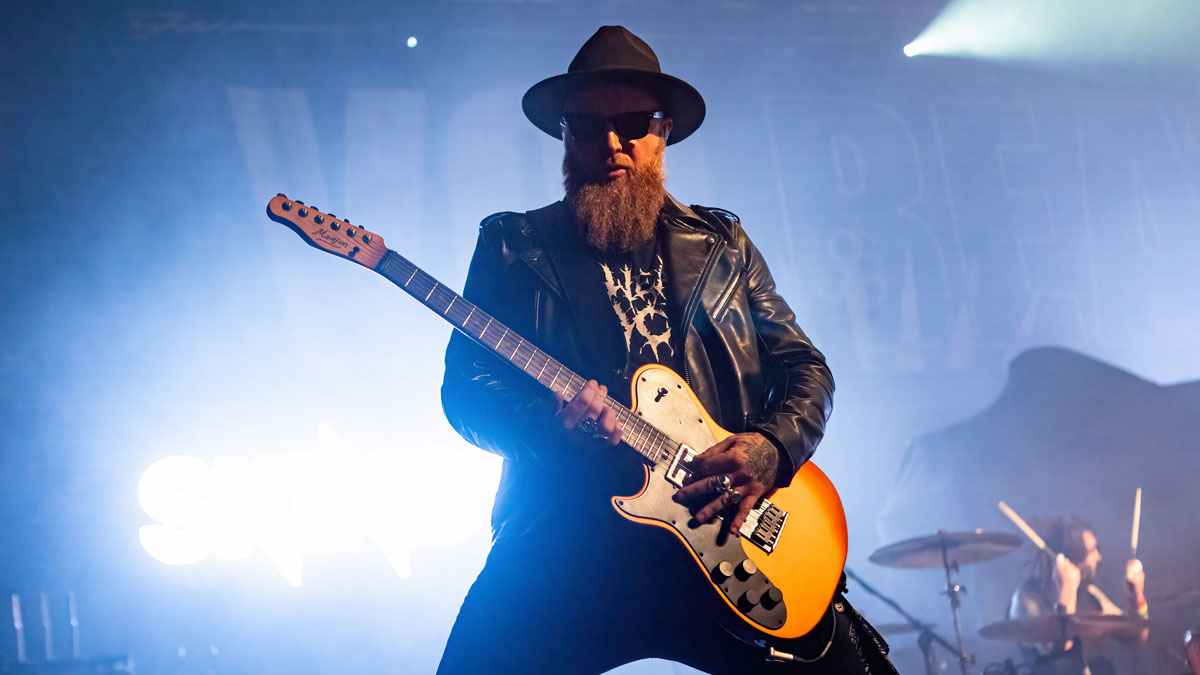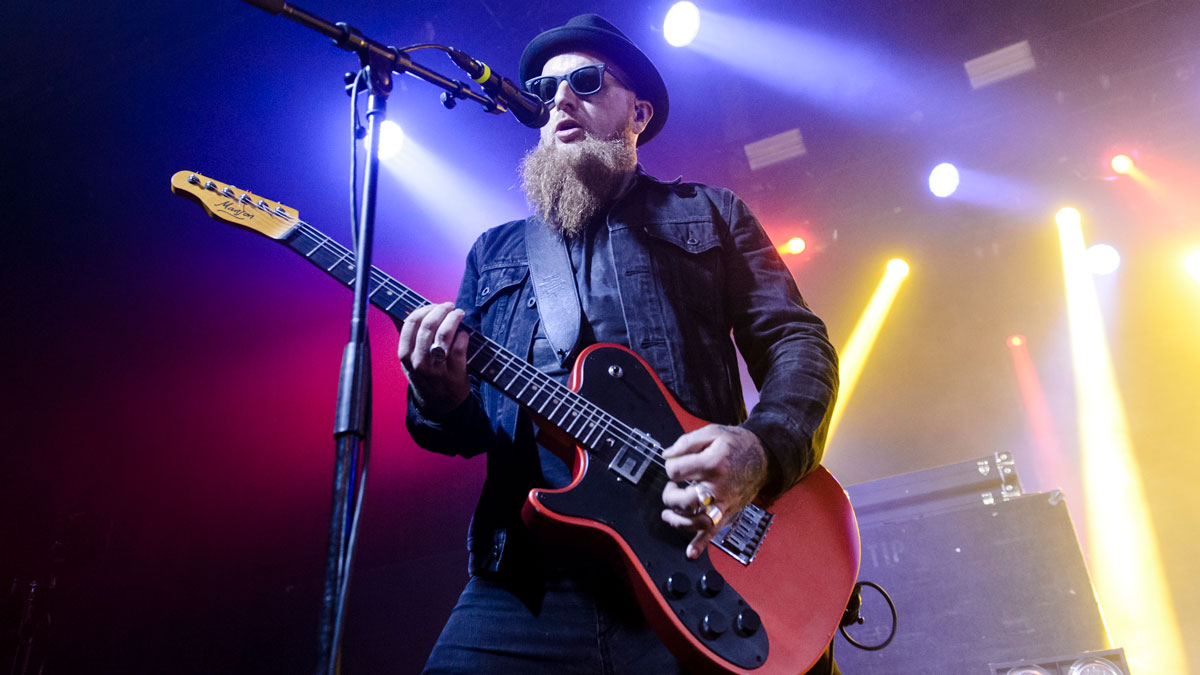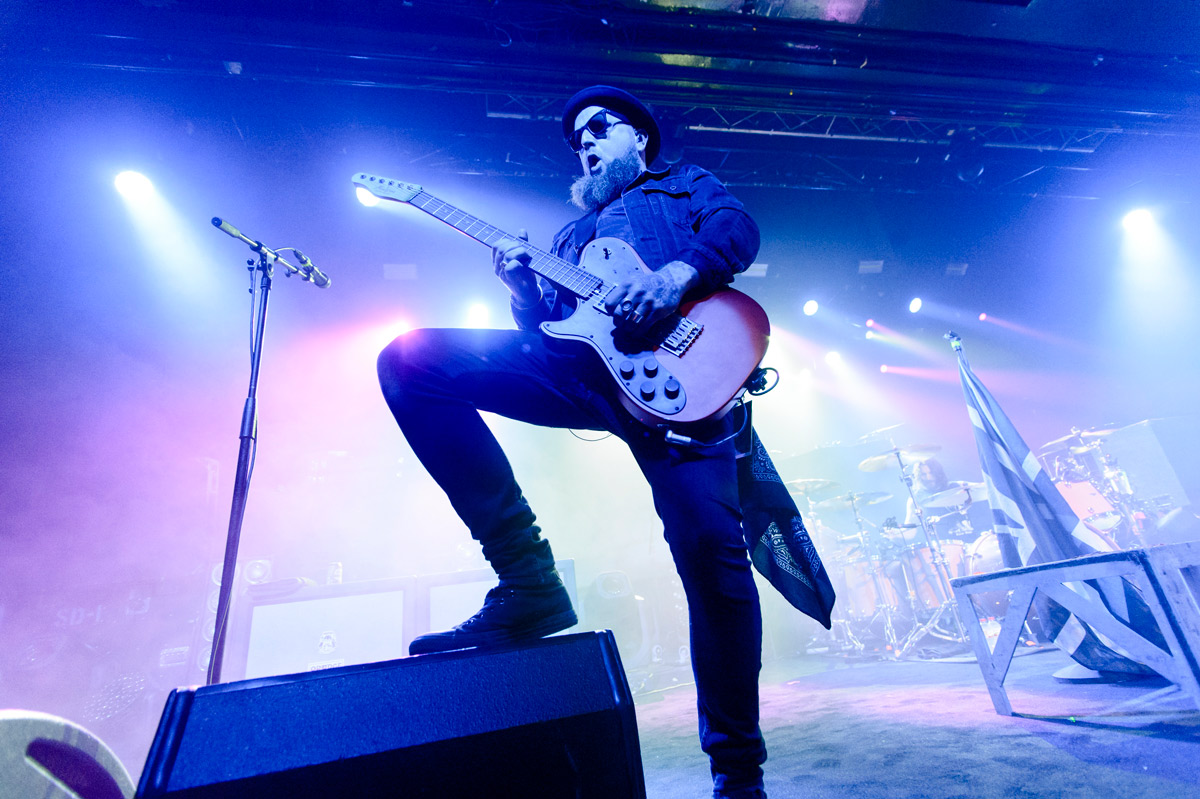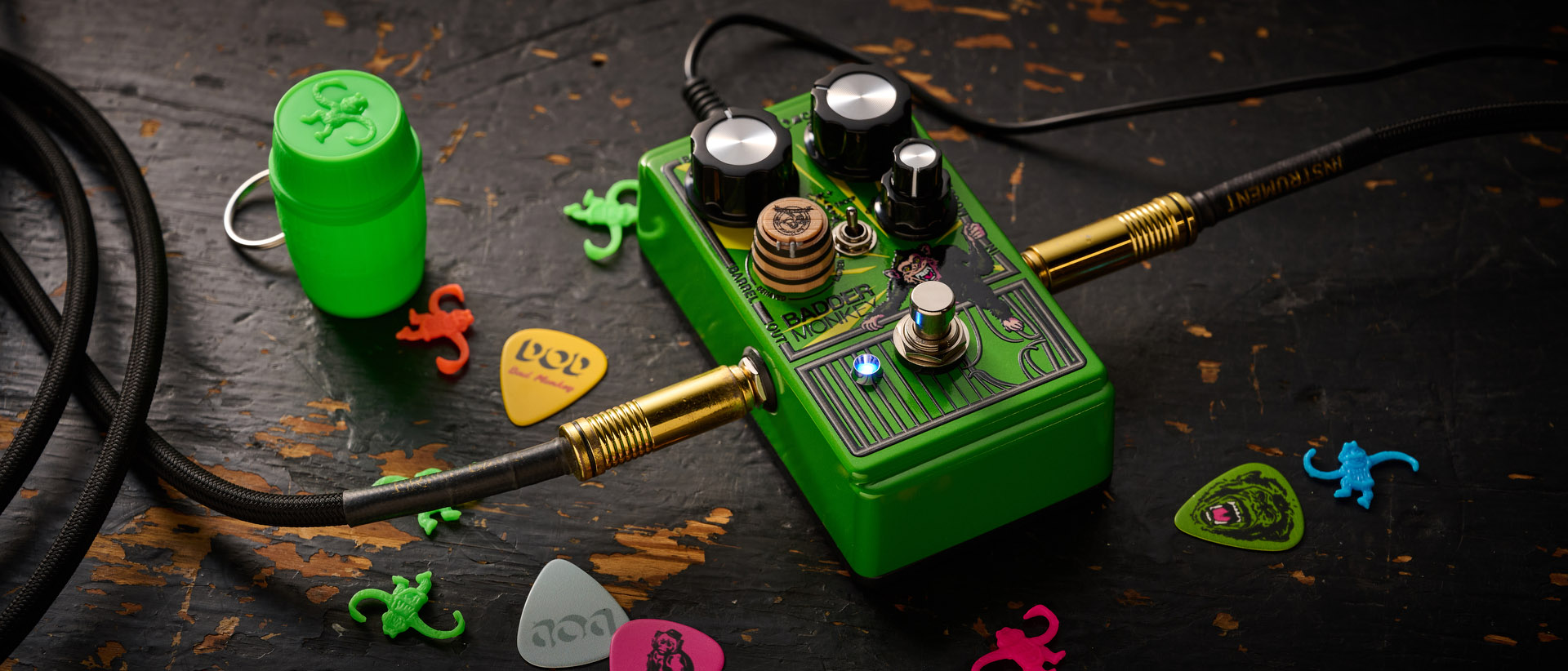Mikey Demus: “For me, it's not about lead prowess – I just value something being memorable. If you can play something that moves someone, that's the ticket”
The Skindred guitarist on the evolution of his signature Manson model, what sets his pedal company Redbeard Effects apart, the pros and cons of being a leftie and why drop D was a “total game changer”

Mikey Demus is best known for his snazzy beard and assuming riff duties with UK ragga-metal export, Skindred. The Welsh band have established a loyal fanbase across the British Isles, bringing together anyone who appreciates a healthy blend of metal, punk rock, ska and reggae.
Outside of Skindred, Demus has taken up a selection of other projects, including his new two-piece act, King Sugar.
On Run On, King Sugar's 2022 single with English singer-songwriter Jamie Bower, Demus offers a solo akin to an old film about a western outlaw. “We used a lot of vintage amps – no plugins,” Demus tells Guitar World.
Part of what makes Demus exceptional as a player is his ability to recognize that less is often more. “For me, I like solos that someone can sing out loud rather than showing off speed,” he says.
With swagger and character being key components of his playing, Mikey Demus's guitar style is a nod to soulful, melody-based innovators like Chris Cornell and Kurt Cobain. As far as gear goes, Manson Guitars has him covered: his signature guitar has a Tele-style pickup and a humbucker in the neck.
We caught up with Demus to discusses his tour with Skindred, Volbeat, and Napalm Death, that Manson signature, Redbeard Effects, and recording with Jamie Bower.
Your first guitar gear included a Fender Mexican Standard Stratocaster. Why were you initially drawn to that guitar?
All the latest guitar news, interviews, lessons, reviews, deals and more, direct to your inbox!
“I think just the way it looked, to be honest. The thing that put me onto it was the fact that it’s a Hendrix guitar! While I wasn’t trying to kid myself about trying to be Hendrix, it just spoke to me, you know? I could identify with it and can’t really articulate what I like the most about it.
“I liked the fact that it had lots of pickups, plenty of knobs and switches – plus Fenders are quite simple. They’re not very fussy. They’re working guitars, they’re humble, solid colors – a lot of them look like ’50s cars.
“I really appreciate the artistry and craft that goes into high end stuff, but I’ve always liked Les Paul Juniors, Stratocasters, SGs, stuff that looks as if it's been dragged around a bit. Stuff with a bit of attitude.”
I remember having a serious chat with my left hand going, ‘Listen mate, you are messing up the program. Get it together’
You mentioned that as a younger player you struggled with maintaining a solid rhythm technique, which is surprising because you play a lot of percussive-sounding licks now. What was your biggest obstacle when perfecting your rhythm?
“When I figured out I wanted to play guitar, my dad got me a cheap acoustic with the idea that ‘if you can make something sound half decent on this, then you can move on to an electric.’ Having a steel-string acoustic really built the dexterity up in my fingers.
“I learned barre chords and stuff through watching artists like Kurt Cobain – I never actually had a proper lesson. I figured out all the major and minor chords, and could sound them out. The biggest obstacle for me was articulating the way I was sounding compared to what I was hearing on whatever record I was listening to.
“It was the rhythm aspect, because I had no problem learning chord shapes all day long. You get that muscle memory. My left hand was just tight and not doing what it was supposed to do. I remember having a serious chat with my left hand going, ‘Listen mate, you are messing up the program. Get it together.’ I had to focus all on my left hand and acoustic strum.”
Drop D is something that you described as a “total game changer”. What can playing in Drop D do for a song, and why is it one of your favorites?
“A friend of mine who played guitar showed me some Rage Against the Machine. I believe he was in the grade above me. That was a Drop D riff and it blew my mind. It makes everything sound heavier and opened up my world.”
What are some essential steps that guitar players can take to figure out who they are stylistically? Or is it something that evolves naturally through listening to seasoned players?
“I think it’s something that comes with time. I think people learning now have a massive advantage perhaps over people learning a long time ago because of the ever growing access to resources out there. When everyone starts, it’s natural to sort of want to emulate and copy someone else while trying to find their own identity as a player.
Initially, new players are trying to summon the energy of whoever they look up to, I think. Then you slowly realize you shouldn’t be trying to copy exactly what another guitarist does
“Initially, new players are trying to summon the energy of whoever they look up to, I think. Then you slowly realize you shouldn’t be trying to copy exactly what another guitarist does – that’s the break where you find your own thing. It really just kind of happens. If you never have that realization, you’re probably destined to be a tribute act which is fine and there is nothing wrong with that.
“There’s plenty of need in the world for tribute acts. With any approach to music, it’s all time spent listening, playing, articulating, and understanding. I’m still figuring out who I am, it changes all the time.”
You have tour dates going into December with bands Volbeat, Napalm Death, and Bad Wolves. What are your must-have gear choices during touring?
“I use Manson Guitars, which are made in Exeter, England – I have a signature model with them. I have a few of those that I take on the road since we play in a couple of different tunings. I pretty much have a main and a spare.
“At most, I’d say four guitars – if I’m feeling really fancy, I’ll bring out another guitar for one song on occasion. That’s either if it looks really cool or has something to do with the theme of an album.
“At the end of the day, I tend to keep it pretty minimal. I sometimes have a couple of acoustics I’ll take out if there’s any unplugged material on the road. I use Kemper pretty much exclusively just for portability’s sake and consistency.
“Consistency is so important – I programmed all of my amp collection; I have them all in there. Any time I have a conversation about Kemper being any good, I say it gets the job done, it’s close enough to a real amp that it’s doing 95 percent of the job, and most importantly it sounds the same every night. That’s a good thing from an audio perspective in regards to having a consistent live sound.”

How did your signature guitar with Manson evolve?
“When Manson approached me about doing a signature model, I had known about them for a long time already. The drummer from Skindred is from the same town as them in the UK, so it’s a bit of a family vibe. They sent me a couple of production guitars to try out, which had a lot of features I loved, plus some stuff I wanted to change.
“In my mind, I wanted to do a Keith Richards sort of Tele Custom-looking model with Les Paul-ish controls – with a more modern take. It’s not necessarily a vintage-looking guitar; it has a modern swing to it. It has a humbucker in the neck and Tele-style pickup in the bridge, big scratchplate, big pickguard, six saddles, locking tuners, and high-output pickups. I had to make it a really obnoxious orange color as well. They made a black one, too, and I have several of both.
“It’s lightweight with bolt-on necks, and the necks are quite thin. Ultimately, it’s kind of like a Tele with a gnarly ceramic humbucker in the bridge, single coil-sized.”
I’ve always been a song person – a songwriter. Guitar is my instrument but it's never been a vehicle for me to really show off lead prowess
With Skindred, you’ve released seven studio albums. What is your recording process for leads and did it differ from album to album?
“Every record has been totally different. I have more of an overdubs approach to playing rather than ‘this is where the solo is going to happen.’ Our singer has a tendency to sing over everything – leaving himself absolutely no breathing room to do anything. I only add lead solos where there is a section that is really calling out for some kind of guitar part.
“The only formula I really stick to is I try not to do anything to widdly or too out of my comfort zone. For me, I like solos that someone can sing out loud rather than ‘check out my speed.’ There are always people faster and I’m not a competitive kind of person enough to be like ‘This is what I want to do.’
“I just value something being memorable. If you can play something that moves somebody, that’s great. That’s the ticket. I’ve always been a song person – a songwriter. Guitar is my instrument but it's never been a vehicle for me to really show off lead prowess. More often than not it will be one note played really repetitively over a chorus with a synthy effect to give the section grit.”

What are the pros and cons of being a lefty guitarist?
“The only thing being a lefty is that you’re limited, which can be taken as either a pro or a con. I think it’s probably good for me because if I played right handed I’d be opened up to ownership of God knows how many guitars. Currently I’m limited to what I can have. Otherwise it’s more of an investment piece rather than a usable thing.
“There’s a learning con, because being a lefty can limit you to what you can learn and have a go on, which has always been a bit of a bummer. The pro is that I’m coming around to the idea of ‘less is more’.
“Owning less stuff is where it’s at. At one point I had a guitar room with twenty guitars in it and it didn’t make me any more creative. It was just more stuff to get away of an idea. Another pro is that it's a great talking point for interviews, and it’s an identity thing. There’s unity with other lefties, like a secret handshake.”
I figured that there wasn’t really a UK-based company that was doing pedals designed by a guitar player out there playing massive festivals
In 2019, you started the company Redbeard Effects with fellow guitarist Adrian Thorpe. The effects pedals have since been described as “weird and wonderful”. What makes these pedals unique?
“I figured that there wasn’t really a UK-based company that was doing pedals designed by a guitar player out there playing massive festivals – I wasn’t aware of another guitarist in the UK that was making their own line of pedals, so we figured it was a cool slant on things to form ideas together.
“Adrian already had a few ideas of pedals he wanted to try out that maybe weren’t right for his own brand, so it was an instant bond because I was into it and they were weird – and I like weird stuff. The last one we released was an overdrive – you can pinch a frequency between 80 Hz to about 4K, and it has gain controls on either side of the EQ.
“We do a pedal, the Honey Badger, which is two separate octaves down running alongside this really gnarly fuzz. Another product we have has a really weird mid control that is kind of like a gain control on its own – so when it’s turned all the way up it starts doing really funky stuff.”
You played guitar on Jamie Bower’s song Run On with King Sugar. The solo you ripped oozed Southern soul and rock. Was this improvised?
“It was totally improvised. I’ve never really sat down and figured out a solo unless I sat down, wrote a song, and the guitar part came to me in my mind. Jamie had already come up with how he wanted the song to be, so it was easy for me to sit alongside him listening and noodling.
“We just kinda went ‘Oh that was really good do that again,’ or ‘I liked that bit, do more of that.’ We refined it and did a few takes, cut it up, and what was there was what we were most happy with. Once we got the tones right he was super stoked.
“I was playing one of my signature guitars plugged into an Angry Rhubarb Red Beards effect pedal, which is a parametric overdrive. We used a lot of vintage amps, no plugins. Legitimately vintage, and that vibe brought a lot to the table.”
People today looking for a career in music need to love it and expel any expectation of what you may get out of it
You also teach at the UK’s BIMM Institute – what has been the most rewarding part of your teaching journey?
“The biggest thing for me was seeing young people excited about music, and witnessing the start of their journey. When you cross paths with those people it’s really special and really exciting.
“There are times when students lack confidence or they’re figuring out their identity, but when you listen to their demos you’re like, ‘Wow, this 18-year-old is so talented.’ The overall vibe of what they put out has made me a fan even in their music’s infancy.
“Being a part of a musician’s start is by far the most rewarding. People today looking for a career in music need to love it and expel any expectation of what you may get out of it. It’s tough because the difference between a job and a hobby is getting paid. Once you do get there, it’s hard to stay there. With that said, you really need to have passion for it. Be sure of that, and that you’re in it for the long haul. It’s not easy at all.”
- Skindred tour Europe and the UK through December.
